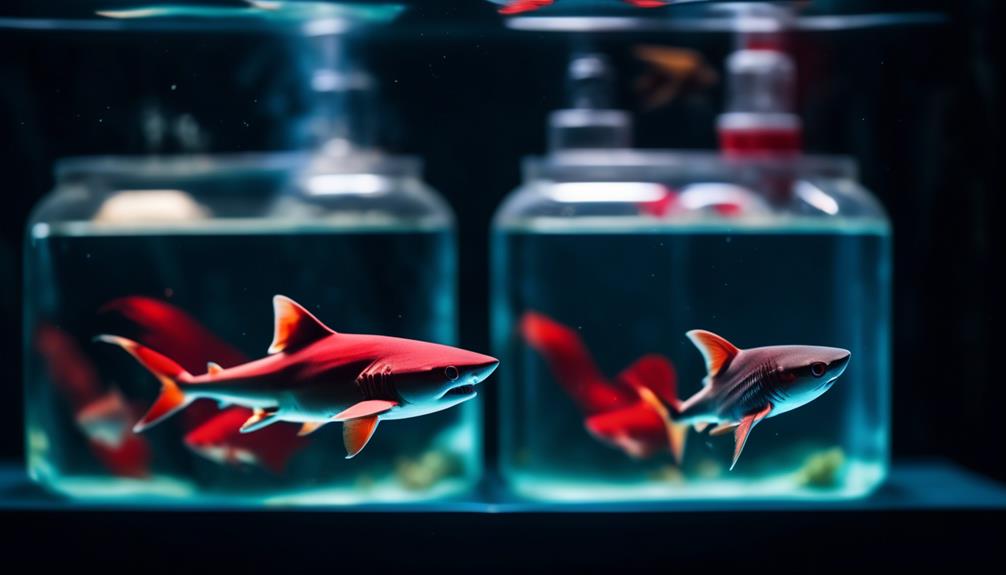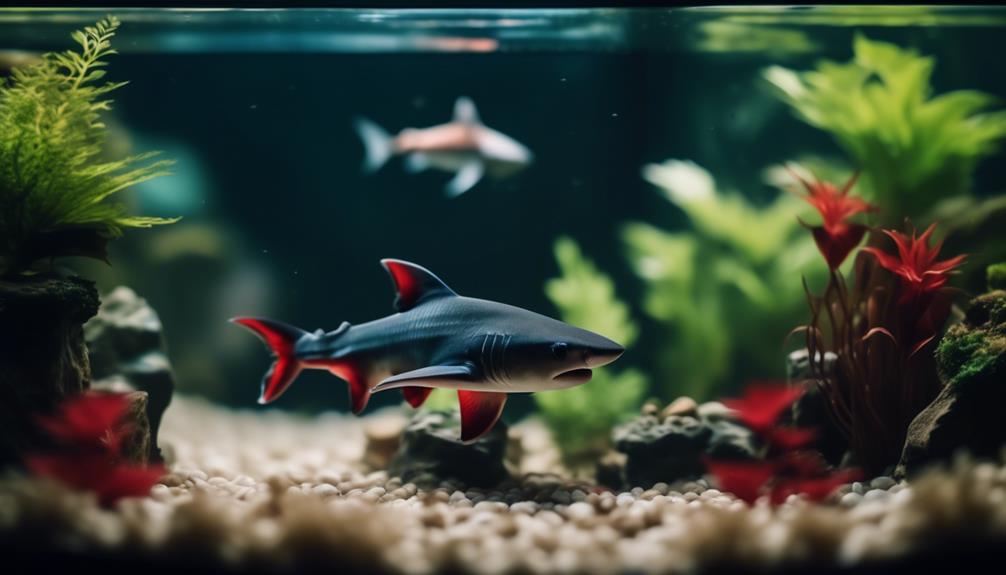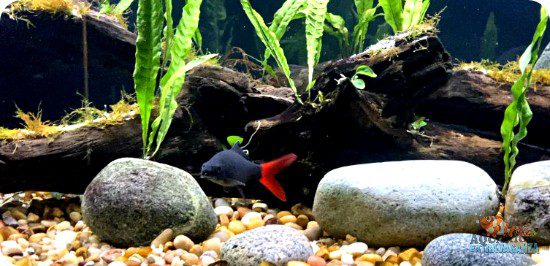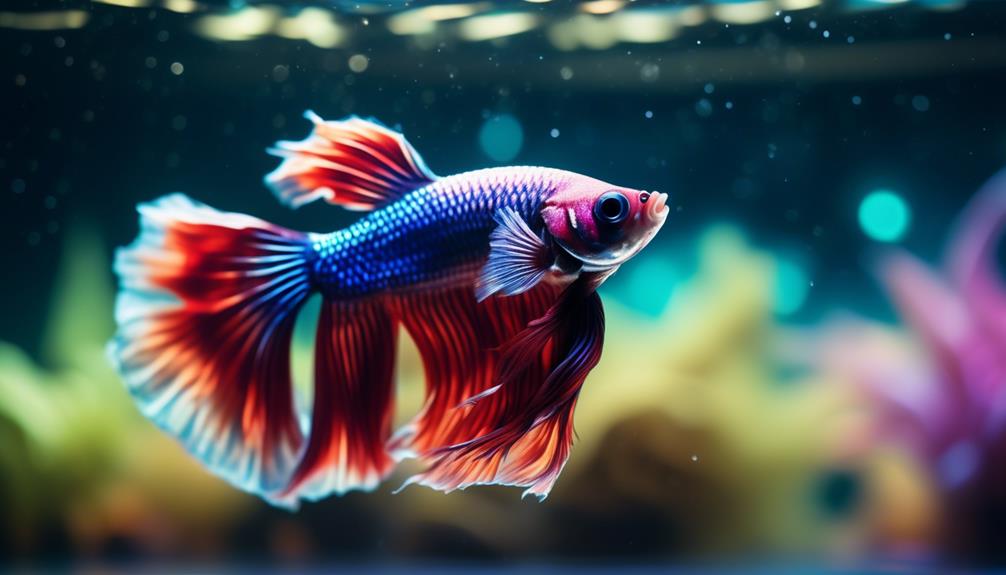One intriguing question that arises in the minds of many Betta owners i have coached is whether a Red Tail Shark can live with a Betta.
Red Tail Sharks are territorial, and Bettas can be aggressive. They are both beautiful but might not get along because of their actions.
Let’s talk about if these fish can live together without problems.
Mike’s Thoughts

Such a combination in a shared tank can lead to stress and harm to your fish.
A spacious aquarium and strategic habitat design are crucial if you attempt to house them together, but caution is advised as it carries significant risk and many years of experience.
I’ve put a bunch more detail below that expands on the topic, so feel free to read on and leave a comment if you have any questions or reach out to me on Facebook.
Understanding Red Tail Sharks
Red Tail Sharks are a popular yet aggressive freshwater fish known for their territorial nature. I’ve learned they’re active swimmers that need plenty of space to roam. It’s important to give them a tank that’s at least 55 gallons, as they can get quite large when they’re fully grown.
The Red Tail Shark (Epalzeorhynchos bicolor) is a freshwater fish that has become a popular choice for aquarium enthusiasts due to its striking appearance and active behavior. Here are some of the main characteristics of the Red Tail Shark:
Appearance
The Red Tail Shark is easily recognized by its deep black body and contrasting vivid red tail. The body is elongated and somewhat cylindrical with a flat belly.They have a pointed snout and an upright dorsal fin.
The fish is not a true shark but is named for its shark-like dorsal fin and sleek body shape.
Size
In captivity, Red Tail Sharks typically grow to about 4 to 6 inches (10 to 15 cm) in length. However, they can reach up to 6 inches in the wild.
Lifespan
With proper care, Red Tail Sharks can live for 5 to 8 years in an aquarium setting.
Behavior
They are known for their territorial nature, especially as they mature. It is common for Red Tail Sharks to claim a certain area of the aquarium as their own and defend it against other fish.
These fish are generally active swimmers and are often seen patrolling the bottom regions of the tank.
If I were to consider adding a Red Tailed Shark to my tank, I’d have to think carefully about who their tank mates would be. It’s best to keep them with fish that can hold their own but aren’t too aggressive. Otherwise, it’s like putting two bullies in the same room—they’ll probably start a fight. It’s all about balance and making sure everyone’s got the space they need to feel at home.
Tank Requirements
Red Tail Sharks prefer larger aquariums with a minimum of 55 gallons to provide enough space for swimming and territories.
The water temperature should be kept between 72 and 79 degrees Fahrenheit (22 to 26 degrees Celsius), with a pH level of 6.5 to 7.5.
Tank Decoration
They thrive in tanks with plenty of hiding spots, such as caves, rocks, and dense vegetation, which help to mimic their natural environment and reduce stress.
Diet
The inclusion of plant matter is especially important in a juvenile Redtail’s diet, as a deficiency of vegetation can cause the fish to lose their color and fail to grow. Redtails do well on a diet of flakes, pellets, frozen, and live foods. Like your betta, Redtails enjoy bloodworms, brine shrimp, and daphnia, and they will also eat algae and fresh boiled veggies such as peas, lettuce, zucchini, and cucumber.
It’s a good idea to feed your betta and your Redtail at opposite ends of the tank to prevent a greedy betta from grabbing all the food, leaving his tankmate to go hungry. Feed both fish two to three times daily, offering them enough food to keep them occupied for just a couple of minutes.
Betta Fish Characteristics
Betta fish, with their vivid colors and dramatic fins, are unique in that they can breathe air directly from the surface due to a special organ called the labyrinth. This is a handy trait for living in low-oxygen water conditions. Male betta fish are particularly striking, sporting longer, flowing fins compared to females. But they’re not just about looks; they’ve got personality too.
One thing I’ve learned about bettas is that they’re not the social type. They prefer solitude and are known to be aggressive toward other fish, especially if there’s not enough space. That means if you’re thinking about pairing them with other fish, like a red tail shark, you’ve got to consider their need for personal space.
Bettas are carnivores, so their diet consists mainly of proteins. They thrive on high-quality pellets made just for them or a treat of live or frozen foods.
As for their home, they’re pretty adaptable, but they do best in warm water that stays between 78-80°F.
Red Tail Shark Characteristics
Importance of Tank Size
While considering a betta’s preference for solitude and its territorial nature, it’s crucial to focus on the significance of tank size for maintaining harmony in an aquarium. Redtail sharks need plenty of room to swim, and a betta also requires adequate space to establish its territory. A small tank can lead to stress and aggression.
Red Tail Sharks are active swimmers and need a large tank to thrive. When I set up my community tank, I made sure it was spacious enough for all inhabitants. The larger the gallon tank, the better it is for reducing conflicts. For instance, a juvenile Redtail shark can start in a 29-gallon tank but will eventually require a 55-gallon tank or more as it grows.
Here’s a simple table to outline the tank requirements:
| Fish Species | Minimum Tank Size |
|---|---|
| Juvenile Redtail Shark | 29 gallons |
| Adult Redtail Shark | 55 gallons |
| Betta Fish | 5 gallons |
A well-sized tank allows me to create separate areas and hiding spots that help minimize the chances of the fish encountering each other often. I’ve always found that monitoring their interactions, especially during the initial adaptation phase, is critical in a large tank to ensure they can coexist peacefully.
Creating a Harmonious Habitat
Creating a harmonious habitat for a Red Tail Shark and a betta involves careful planning and strategic aquascaping to ensure each species has its own territory. I know that Redtail sharks can be aggressive, and they often chase other fish that invade their space. So, I need to create hiding spots and barriers within the tank to help the betta stay out of the shark’s way.
I’m aware that the water temperature is crucial for both. They need warm water, but not too hot or too cold. I’ll monitor the temperature regularly to make sure it’s just right. Also, I’ve got to provide enough food for both fish. I don’t want the shark getting hungry and nipping at the betta’s fins.
It’s also in my plans to watch them closely, especially at the start. If I see the shark being too pushy, I might’ve to separate them temporarily. I’ve got a backup tank ready, just in case. I’m committed to making it work, though, because I believe it’s possible for Redtail sharks and bettas to live together peacefully if their home is set up right.
Dietary Needs
Addressing the dietary needs of Red Tail Sharks and bettas requires careful attention to their distinct feeding habits.
Redtail sharks lean towards a herbivorous diet. They need food rich in veggies for their color and growth. I can feed them flakes, pellets, and both frozen and live foods like bloodworms and brine shrimp. Boiled veggies are also a good choice.
On the flip side, when I feed my betta, I’ve to remember they’re carnivores. They love pellets and flakes designed for them, as well as live or frozen foods. It’s important that I don’t mix up their diets. Every fish needs the right kind of food to stay healthy.
To make sure both get what they need, I feed them separately. This avoids any food competition. If they fight over food, they might become stressed. Stress is bad for fish and can lead to health problems.
I always try to give them a variety of foods. This way, they get all the nutrients they need. By meeting their dietary needs and feeding them properly, I help keep my fish in top shape.
Managing Water Conditions

After ensuring the dietary needs of my Red Tail Shark and betta are met, I also focus on maintaining the right water conditions for their health and harmony. It’s crucial to regularly monitor the water quality in the tank. I keep an eye on the temperature, pH, and ammonia levels. Both redtail sharks and bettas are tropical fish, so they need warm water. I make sure the temperature stays consistent.
I also use a good filtration system. It keeps the water clean, which is essential for the health of my fish. Every week, I do water changes. This helps get rid of harmful waste that could make the fish sick. I’m always careful to match the water conditions when I add fresh water. The new water must be the same temperature and pH as the tank.
I took special care when I first introduced my Red Tail Shark to the betta. I slowly acclimated the shark to the tank. This way, I avoided stress that might lead to fighting. Managing water conditions is a big part of making sure my redtail sharks and bettas can live together without issues.
Strategies for Successful Cohabitation

To make sure both the Red Tail Shark and the Betta can live together, I’ll need to think about how big their tank should be.
I’ve learned that bigger tanks can reduce fighting by giving each fish more space.
I’ll also look into ways to keep aggression low, like adding hiding spots and keeping an eye on their behavior.
Tank Size Considerations
When considering tank size for housing both Red Tail Sharks and Bettas together, it’s crucial to ensure ample space, with a minimum of 29 gallons for young sharks and 55 gallons for adults, while Bettas thrive in spacious, horizontally-oriented tanks.
I’ve learned that the tank must be well-planted with features like rocks and driftwood. These create hiding spots for the Betta and territories for the Redtail.
Both fish prefer similar water conditions, which is good news. I’ve made sure the pH is between 6.8 and 7.5 and the temperature stays between 72° and 82° Fahrenheit.
Aggression Management Techniques
Ensuring the Red Tail Shark and Betta can live together peacefully demands strategic aggression management techniques. Here’s how I manage the potential feuds:
- Monitor Behavior: I keep a close eye on them, especially at the start. If the red tail shark chases or nips, I know it’s time to intervene.
- Separate Temporarily: When I see signs of stress, like if the betta starts to lose their color, I’ll separate them using a vase or pitcher as a temporary home for the betta.
- Understand Compatibility: Before I even put them together, I learned about what makes sharks are tropical and bettas comfortable. I’ve made sure my tank meets these needs to reduce the chance of conflict.
Short sentences and simple words make the steps clear, right?
Frequently Asked Questions
Can Betta Fish Live With Shark Fish?
I’ve found that compatibility challenges arise when mixing betta fish with shark fish due to territorial behavior. Tank size, water parameters, and enrichment needs must be considered to avoid potential conflict.
What Fish Can You Put With a Red Tail Shark?
I’m researching which fish are compatible with Red Tail Sharks. I’m considering aquarium size, water parameters, and feeding habits. It’s crucial to ensure tank decoration harmony for a peaceful aquatic environment.
What Fish Can Be Kept With Bettas?
I’ve found that bettas thrive with peaceful companions. They need proper tank size, stable water parameters, and plant hiding spots. Ideal mates are surface dwellers that don’t invade the betta’s territory.
How Aggressive Are Red Tail Sharks?
I’ve learned red tail sharks display strong territorial behaviors and a dominant tank hierarchy, often leading to feeding competition. Their shark temperament can cause stress indicators in other fish due to aggression.
Conclusion
In conclusion, mixing Red Tail Sharks with Bettas isn’t a great idea. Red Tails can be bullies, and your Betta’s fancy fins are a tempting target. To avoid trouble, give them separate homes.
If you’re set on trying, though, you’ll need a big tank, smart decor planning, and careful monitoring. But honestly, it’s risky.
Keeping fish is about their comfort, not just ours, so let’s choose tankmates that’ll keep everyone happy and healthy.

